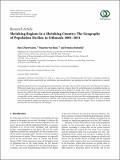Files in this item
Shrinking regions in a shrinking country : the geography of population decline in Lithuania 2001–2011
Item metadata
| dc.contributor.author | Ubarevičienė, Rūta | |
| dc.contributor.author | Van Ham, Maarten | |
| dc.contributor.author | Burneika, Donatas | |
| dc.date.accessioned | 2017-09-04T11:30:16Z | |
| dc.date.available | 2017-09-04T11:30:16Z | |
| dc.date.issued | 2016 | |
| dc.identifier | 250961711 | |
| dc.identifier | e25937eb-8ac1-4ff8-a34b-de9ac8d61942 | |
| dc.identifier.citation | Ubarevičienė , R , Van Ham , M & Burneika , D 2016 , ' Shrinking regions in a shrinking country : the geography of population decline in Lithuania 2001–2011 ' , Urban Studies Research . https://doi.org/10.1155/2016/5395379 | en |
| dc.identifier.issn | 2090-4185 | |
| dc.identifier.other | ORCID: /0000-0002-2106-0702/work/64697479 | |
| dc.identifier.uri | https://hdl.handle.net/10023/11609 | |
| dc.description | The authors would like to thank the Research Council of Lithuania [Grant no. DOC–13/2014] for financial support for the academic outing to Delft University of Technology, Netherlands. Part of the research leading to these results has received funding from the Marie Curie programme under the European Union’s Seventh Framework Programme (FP/2007–2013)/Career Integration Grant no. PCIG10-GA-2011-303728 (CIG Grant NBHCHOICE, Neighbourhood Choice, Neighbourhood Sorting, and Neighbourhood Effects). | en |
| dc.description.abstract | Shrinking populations have been gaining increasing attention, especially in post-socialist East and Central European countries. While most studies focus on specific cities and regions, much less is known about the spatial dimension of population decline on the national level, and the local factors determining spatially uneven population change. This study uses Lithuanian Census data from the years 2001 and 2011 to get insight into the geography of population change for the whole country. Lithuania has experienced one of the highest rates of population decline in the world in the last decades. The predictive models show that regional factors have a strong effect on the variation in population change throughout the country, but also reveal that socio-demographic and economic area characteristics play a role in the process of decline. Our results give little hope to those who would like to reverse the ongoing trends of population change and emphasize the need for spatial planning to cope with the changes. This is an approach which currently does not exist in practice in Lithuania. | |
| dc.format.extent | 18 | |
| dc.format.extent | 29517990 | |
| dc.language.iso | eng | |
| dc.relation.ispartof | Urban Studies Research | en |
| dc.subject | GE Environmental Sciences | en |
| dc.subject | H Social Sciences | en |
| dc.subject | NDAS | en |
| dc.subject.lcc | GE | en |
| dc.subject.lcc | H | en |
| dc.title | Shrinking regions in a shrinking country : the geography of population decline in Lithuania 2001–2011 | en |
| dc.type | Journal article | en |
| dc.contributor.institution | University of St Andrews. School of Geography & Sustainable Development | en |
| dc.identifier.doi | 10.1155/2016/5395379 | |
| dc.description.status | Peer reviewed | en |
This item appears in the following Collection(s)
Items in the St Andrews Research Repository are protected by copyright, with all rights reserved, unless otherwise indicated.

